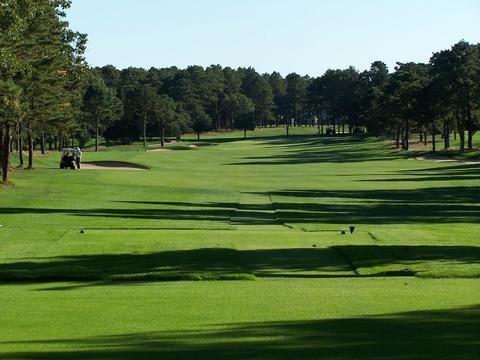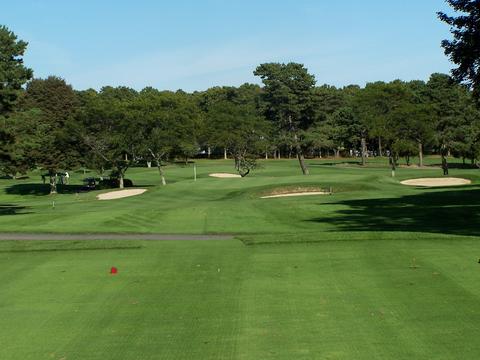
Like so many holes at Oyster Harbors, the 2nd looks fairly tame from the tee, but all the action begins on or around the greens. I would have welcomed a three-putt today.
For many reasons, I won't forget my last two days at Oyster Harbors, one of the most celebrated of all Donald Ross courses. I played miserably, with no excuses for missing the very generous fairways on the course and hitting about five greens in regulation. My partner, Bob Penney, was quite tolerant. I barely broke 90 on the first day, and didn't on the second, my only compensation being that no one could accuse me of sandbagging with my 10 handicap. The capper was the five putts I took on the 2nd hole today, something I had never done in more than 45 years of golf. When you can play like that, still smile coming off the last hole and consider the two days very well spent, you know you have been in the company of fine fellows and a phenomenal golf course.
Fine fellow Dick Farr is the eminence behind what has come to be called the "Fall Frolic." A member of the private Oyster Harbors, which is located in Osterville, MA on Cape Cod, Dick has organized the outing for the last 25 years as a way to gather his friends to appreciate a great golf course, share their passions for the game and have a wonderful dinner (the food at Oyster Harbors is first rate). Over time, Dick's friends' friends have become his as well. I learned all this during Dick's dinner "pontifications" (his word).
There is certainly some "frolic" to the two days. Each of the 50 participants is assigned a partner with a similar handicap. The game is net better ball of two, but with a twist best described as "best of the worst." Of the 18 scores not used for the best ball, each team was required to add up the best 12 of them and then add that total to the best ball total. Also, on day one, everyone had a chance to guess the total score of all 50 participants on the short, but tricky, par 5 2nd hole. I thought I was pretty smart with my estimate of 333 strokes, about a 6.3 average. And during the round, when I saw the pin at the bottom of a whale of a hill (literally), I figured the field could not break an average of bogey on the hole.
Well, I underestimated; the average came in at 5.5 strokes. Well done, field!
The wonderfully groomed course itself is frolicsome, when it isn't frustrating in the classic Donald Ross way, which is to say the wide fairways give no indication of the terror that awaits at and near the green. Greens are undulating, generally not wildly so but enough to make your knees knock. I had a few putts that broke five feet or more, but I found those a lot easier to read than the more subtle putts that wound up breaking less than the width of a cup (and often the "wrong" way). Pin positions the first day were in corners and at edges, and any miss on the short-side yielded bogey at best. The Ross bunkers were snuggled up to the greens in some places, but some of the larger traps extended to 30 yards in front; misplayed shots into the stiff breezes resulted in some difficult long explosion shots. Fairway bunkers on some holes make you think, and others are only in play if you scuff your drive off the tee.
But everything is about the green complexes at Oyster Harbors, and at dinner, fellow golfers who had played Ross' famed Pinehurst #2 described Oyster Harbor's greens as every bit as tough (some felt strongly that Pinehurst's fairways are more generous). Oyster Harbors' greens are all difficult, but a few are punishing in the extreme if the pin is in the wrong place, none more so than at the otherwise mild-mannered 2nd hole, which plays as a par 4 or par 5, depending on which tees you play.
I met my Waterloo today at #2. The pin was perched on the edge of a swale that runs in a small arc from right front to middle rear on a medium-sized green. I had hit a good drive into the wind, a good three wood lay-up and then a crisp 9 iron I thought was stiff. It landed a few feet short of the pin and then, without making a dent in the green, rolled back 25 feet below the hole.
My putt was directly uphill (always a good thing at Oyster Harbors) with a right to left break of about three feet. I felt confident, despite the warning of the group in front of us to "be careful; two of our guys five putted." I hit the best putt I had hit in weeks and thought it was going in, but two turns from the hole it dove left and stopped just six-inches below the hole - stopped, that is, for a microsecond before it began its descent down the hill, picking up speed and stopping 20 feet below the hole.
Now I had a straight uphill putt, another one I thought I hit perfectly, but it broke left instead of right, and this time wound up two feet above the hole. At least it stopped. At the Fall Frolic, no putts are conceded, and thinking more about the last two putts than the next, my comeback two-footer nicked the right edge of the cup and away it went, down the hill to the magic 20-foot mark again. Two more strokes and I was done, with the only 8 on my card this year and the only five-putt of my golfing career. Later, I learned that one of the other guys in the field had picked up on the hole...after seven putts.
The par 72, 6,514-yard Oyster Harbors could be the toughest course in America with a rating under 72 (it's 71.2) and a slope under 130 (it is way under-rated at 126). It is exciting and exhausting all in one. It would be interesting to hit every shot where you want to on the course and see what kind of score you could produce. With a straight drive and approach shot below the hole, it is possible to score well. One fellow in our group today played beautiful position golf and shot 76. The low round the first day was a 75, and the fellow had a triple and a double bogey. And that is probably the essence of a course like Oyster Harbors; you can score well, but somewhere along the way, and most assuredly it will happen on a green, there will be pain. Exquisite pain.

Some pin positions at Oyster Harbors, like this one at the par 3 17th, are what they seem -- diabolical.























